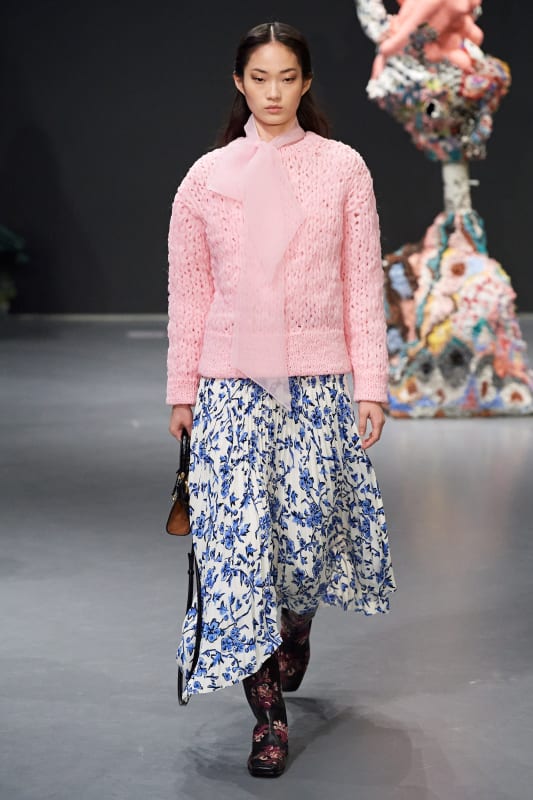Vogue Runway writes: One way to look at Tory Burch’s terrific fall collection is it defined what happens when you put two creative individuals—that would be Burch and New York artist Francesca DiMattio—in conversation with each other.
DiMattio designed many of the floral prints Burch used, including those on bias-panel dresses that were a bricolage of splashy flowers on silk mixed with 3-D sequined beading; long pleated skirts with undulating hemlines, one worn with a particularly lovely thread-trailing sweater; and a series of handheld purses that somehow contrived to be both structured and slouchy and were successful in achieving just that.
Burch is an admirer of DiMattio’s monumental ceramic sculptures, which fuse towering abstracted female forms with all manner of very fecund-looking flowers. She situated many of the artist’s pieces on a runway formed out of a series of connected rooms at Sotheby’s, on New York’s Upper East Side. Burch is a collector too, having bought, she mentioned at a preview of the collection, a vaselike piece that had been formed to look as though it had collapsed under the weight of the flowers it contained.
Of course, DiMattio’s work also has a sly and subversive quality; a twist to the art historical objectification and deification of the female body, and of iconography long associated with the feminine sphere: As well as those flowers, there are the soft pastels, wedding beads, basket weaving. “She challenges the idea of femininity and what it means to be feminine,” said Burch. “There’s a challenging of norms; the concept of women and femininity and bias and unconscious bias.”
Factor all that in and you start to take a whole other look at what Burch had going on here; her own slyly thoughtful treatise on many of the things she has become known for in her collections, and a meditation on what power means to women. You can understand why she’d be thinking along those lines, having been dubbed during her career a female CEO, as if her business acumen needed to be qualified by her gender. Clearly, it didn’t—and shouldn’t.
That’s what led Burch to explore tailoring that didn’t resort to aping the cliché of women in suits. Those high-neck Edwardian jackets and lean pants worn with lanky embroidered boots, for instance, were intended as a more personal and intuitive depiction of what being powerful could mean to women today, Burch included. The personal is always up front in her work; the ability to engage women in conversation, whether it’s with her clothes or her philanthropic endeavors.
And it was certainly evident at this show, where she wanted to get away from what she felt had been the somewhat sterile environment of last season and go to the celebratory joy of having someone such as singer Alice Smith—Burch is a fan—perform live. But ultimately, the real personal triumph here was Burch’s; a designer who is challenging herself to be increasingly ambitious in her work, defying the definition of who she is and what she can be—and quite plainly succeeding.

